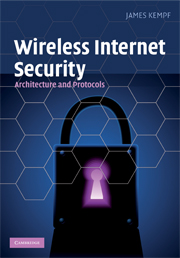Book contents
- Frontmatter
- Contents
- Preface
- Acknowledgements
- 1 Security basics
- 2 Network system architecture basics
- 3 Cryptographic algorithms and security primitives
- 4 Wireless IP network access control
- 5 Local IP subnet configuration and address resolution security
- 6 Security for global IP mobility
- 7 Location privacy
- References
- Index
6 - Security for global IP mobility
Published online by Cambridge University Press: 06 July 2010
- Frontmatter
- Contents
- Preface
- Acknowledgements
- 1 Security basics
- 2 Network system architecture basics
- 3 Cryptographic algorithms and security primitives
- 4 Wireless IP network access control
- 5 Local IP subnet configuration and address resolution security
- 6 Security for global IP mobility
- 7 Location privacy
- References
- Index
Summary
Once a wireless terminal has cleared network access control, obtained an IP address on the local subnet, and has routing service for IP packets between the terminal and the network, the terminal has access to the higher-level services available on the global Internet – Web pages, IP telephony, streaming video and the like. From the point of view of routing and packet delivery service, a wireless terminal is no different than a wired terminal. A desktop PC connected to the Internet through DSL must go through a similar process to get Internet access as a wireless terminal and the resulting routing and packet delivery service is basically the same. Unlike the user of a desktop PC, however, the user of a wireless terminal is free to move the terminal to a new location. Such a movement may cross an invisible line in the access network topology between a geographical area where the current IP address continues to provide packet delivery service and where the address stops functioning. In other words, the terminal moves from one IP subnet to another causing IP handover to occur.
If the user's mobility patterns conform to the nomadic usage model discussed in Chapter 4, then starting network access control and local IP subnet configuration from the beginning are adequate for initiating routing and packet delivery service in the new subnet.
- Type
- Chapter
- Information
- Wireless Internet SecurityArchitecture and Protocols, pp. 130 - 168Publisher: Cambridge University PressPrint publication year: 2008



